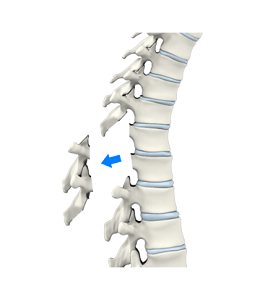
Disease Overview
Degeneration of the facet joints and intervertebral discs results in the narrowing of the spinal canal, known as spinal stenosis. In addition, the arthritic facet joints become bulkier and consume the space available for the nerve roots. Besides, bony outgrowths, also known as bone spurs or bone osteophytes can also narrow the spinal canal.
Spinal stenosis puts pressure on the spinal nerves and spinal cord, causing symptoms such as pain, tingling sensation, numbness or weakness that extends to the extremities, and bowel or bladder impairment.
What is Laminectomy?
Laminectomy refers to the removal or cutting of the lamina (roof) of the vertebral bones to provide space for the nerves to exit from the spine. It can also be performed to relieve the symptoms of the narrowed spinal canal known as spinal stenosis.
Indication of Laminectomy
The objective of laminectomy is to relieve pressure on the spinal nerves by removing the part of the lamina that is applying pressure on the nerves. Your surgeon will recommend laminectomy after examining your spine, medical history, and imaging results of cervical vertebrae from X-ray, CT scan or MRI. Surgery is recommended only after non-surgical treatment approaches fail to relieve symptoms after a reasonable period of time.
Laminectomy Procedure
- The procedure is performed with you resting on your stomach under general anesthesia. Your surgeon makes a small incision at the center of your back and approaches the vertebrae by moving the soft tissues and muscles apart.
- Then, the lamina is partly or completely removed to relieve the compression. Other causes of compression such as bone spurs and/or disc fragments (discectomy) are also removed.
- After the procedure, your surgeon brings the soft tissues and muscles back to their normal positions and closes the incision.
- In some instances, spinal fusion may also be performed along with cervical laminectomy, which involves placing bone graft or a bone graft substitute between the two affected vertebrae to allow bone growth between the vertebral bodies.
- The bone graft acts as a medium for binding the two vertebral bones and allows the growth of a single vertebra, which stabilizes the spine. This helps to maintain the normal disc height.
Postoperative Recovery for Laminectomy
The duration of your hospital stay depends on your treatment plan. In a few instances, surgery may be performed on an outpatient basis, where you will be allowed to leave the hospital on the same day.
After surgery, your symptoms may improve immediately or gradually over the course of time. Your return to work will depend on your body’s healing status and the type of work/activity that you plan to resume. A specific postoperative recovery/exercise plan will be provided by your physician to help you return to normal activity at the earliest.
Risks or Complications of Laminectomy
All surgeries carry risks and it is important to understand the risks of the procedure to make an informed decision to go ahead with the surgery. In addition to the anesthetic complications, spinal surgery may be associated with some potential risks such as infection, blood loss, blood clots, nerve damage, and bowel and bladder problems. Failure to fuse the vertebral bones with the bone graft (fusion failure) is an important complication of spinal fusion, which would require additional surgery.















